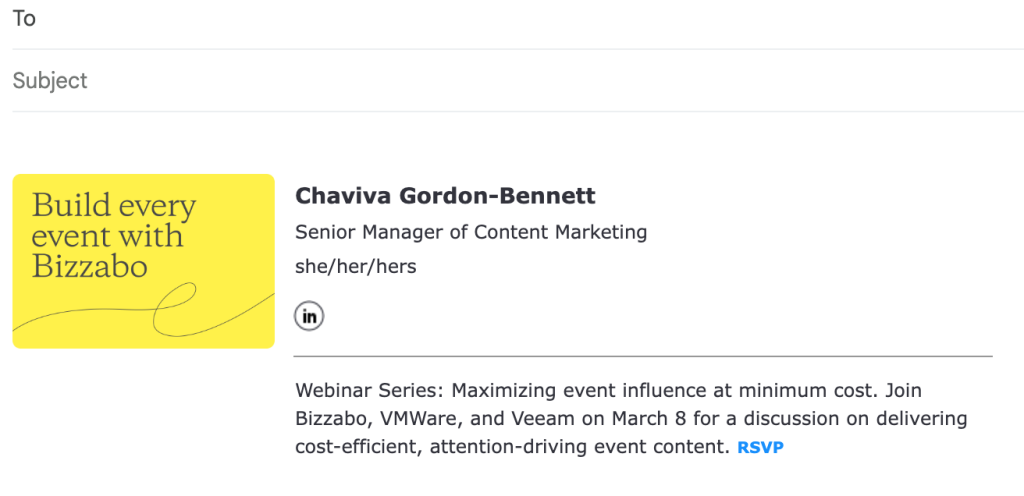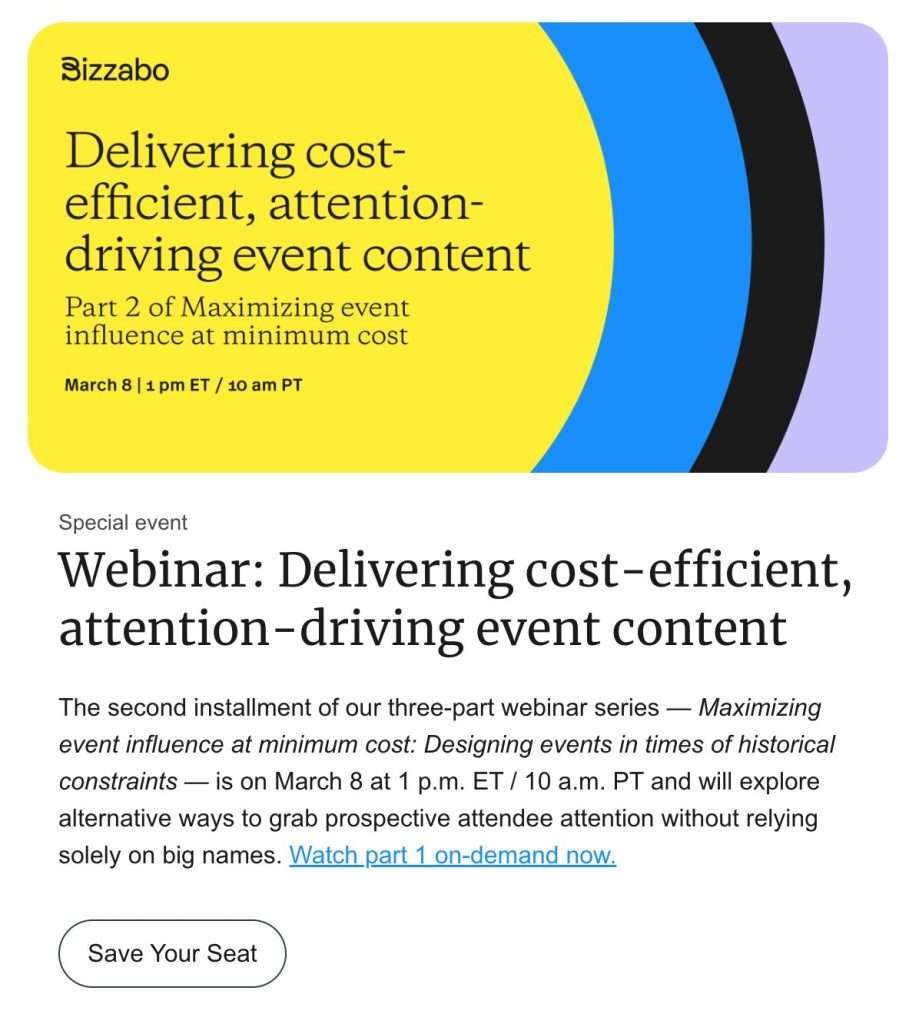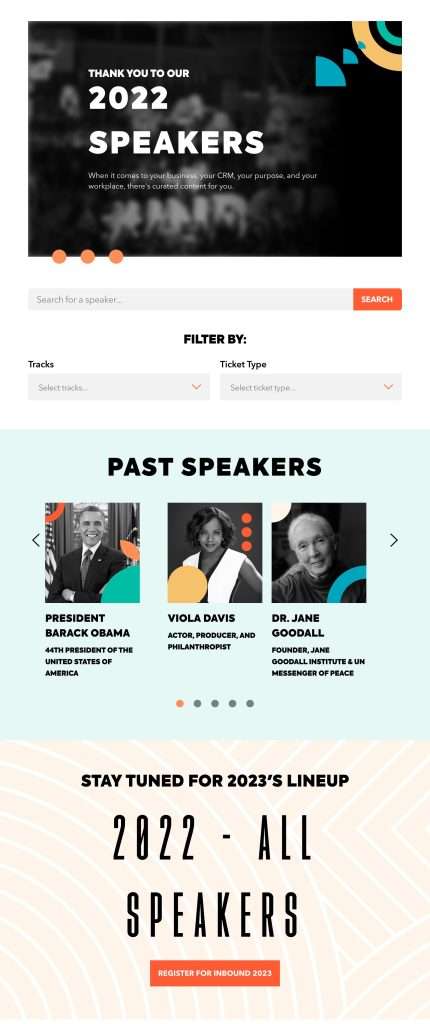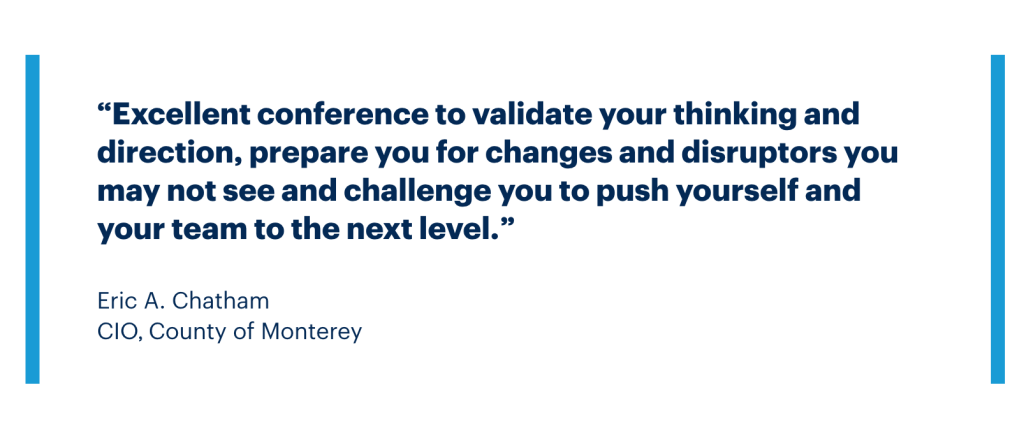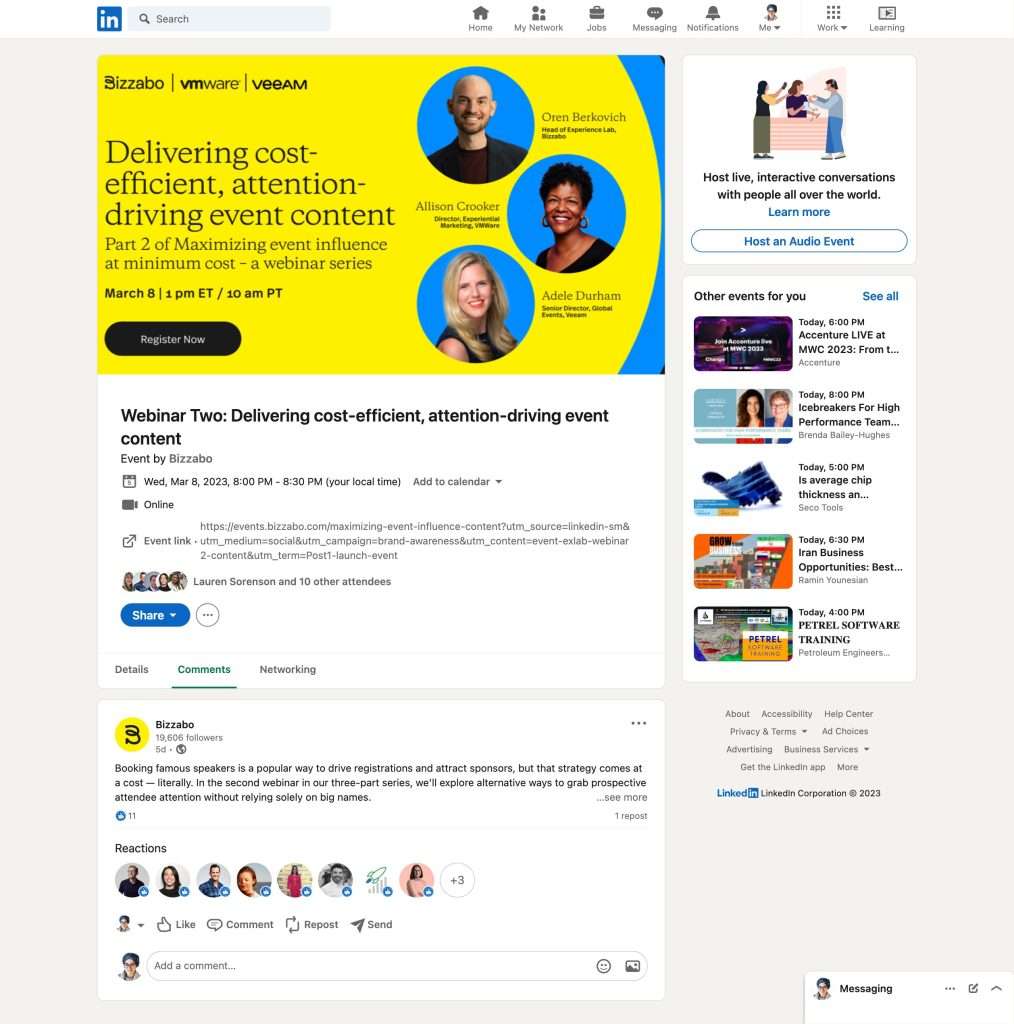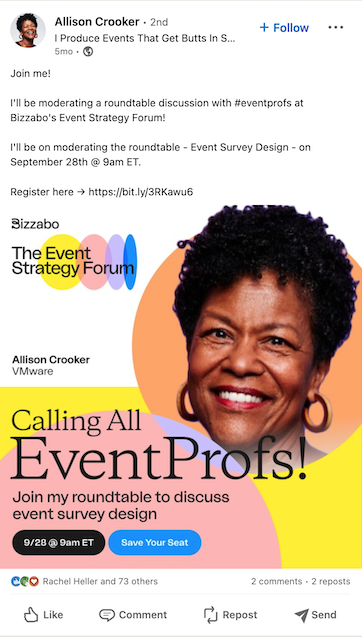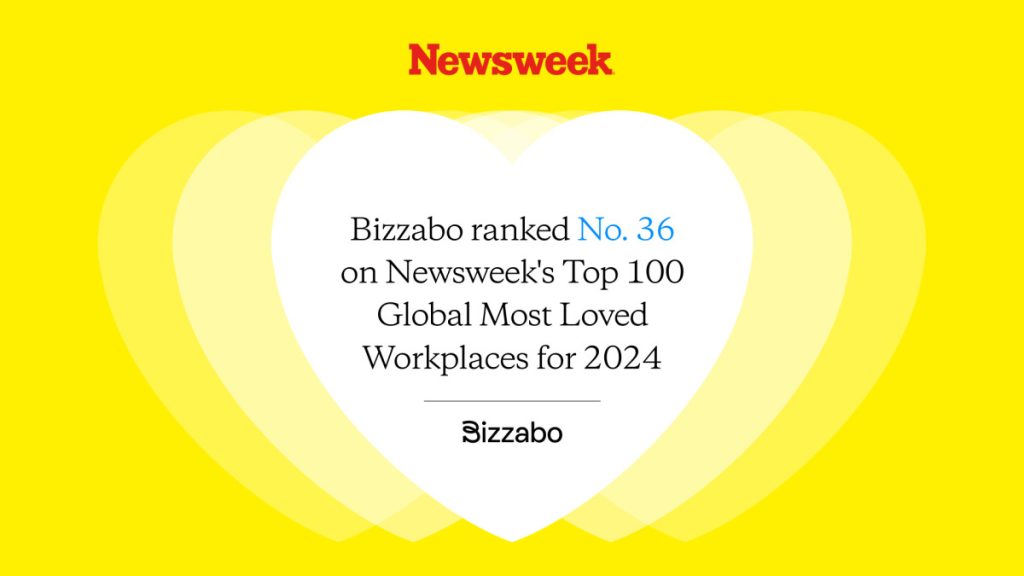Your Ultimate Guide to Successful Event Promotion in 2023

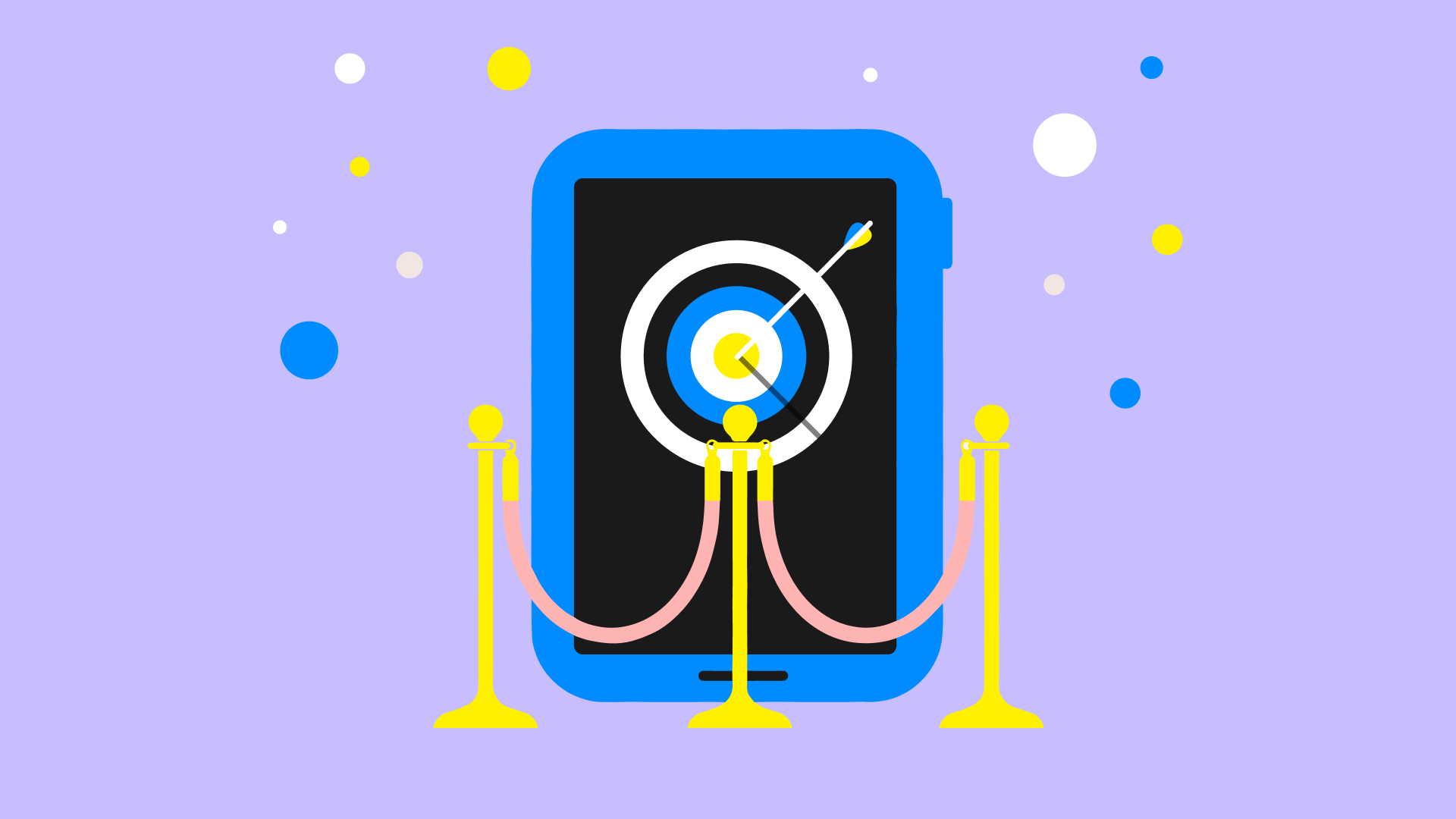
Event websites, email, promo codes, PR, Google Ads, social media, influencers — are you checking all the boxes in your event promotion plan to sell out your event? With so many different ways to market your event, it’s hard to know how to successfully promote your events.
The key is to break down your event strategy into smaller initiatives to make it more manageable, which is exactly what we do in this ultimate guide to event promotion and marketing. Ready? Feel free to skip through the Table of Contents or just start reading.
Table of Contents
- What is event promotion?
- Step 1: Define Your Event Promotion Goals
- Step 2: Align Your Sales and Marketing Teams
- 5 Ways To Leverage Existing Channels
- How To Create Promotional Content From Previous Events
- 7 Ways To Personalize and Segment Event Email Promotion
- 5 Tips for Promoting Your Event on Social Media
- 4 Ideas For Scaling Your Promotional Efforts
- Key Takeaways: How To Successfully Promote Your Events
What is event promotion?
Event promotion uses different marketing strategies and channels to get the word out about your event and ultimately drive event registration and achieve your event’s goals. This can range from digital (email or social media) to print mediums (such as flyers or direct mail).
Are event marketing and event promotion the same thing?
Event marketing typically includes event branding, advertising, analytics and success metrics, and more. Think of event marketing as a broader undertaking that uses events to drive business goals for a product, brand, or service.
Coordinated campaigns that leverage multiple marketing channels (aka an omnichannel event promotion strategy) are the most effective way to promote your event. Depending on your audience, some channels may be more effective than others and it’s fine to stick to what you know works. Be true to your event brand, and don’t feel pressured to use every channel — it’s about quality, not quantity.
Your event marketing and event promotion strategies should seamlessly fit into an integrated marketing campaign. Similar to multi-touch marketing, an integrated marketing campaign starts with identifying your target audience. Then you can determine which marketing channels to leverage and which messaging will resonate with your audience.
Step 1: Define Your Event Promotion Goals
The first step in building your event promotion plan is identifying your event goals. For example, if you’re using an account-based marketing (ABM) strategy to target specific accounts, you may want to target registrations for specific ticket types, which would require building promotions for those tickets and the corresponding attendee personas. Here are some metrics tied to ticket/attendee persona goals:
- Total number of registrations
- Number of paid registrations
- Number of discounted registrants
- Number of free registrants
When aligning your promotional outreach with other teams across your organization, consider creating goals for how many registrants are attributed to specific teams. For example, you may want to track the following:
- Number of registrants from customer success
- Number of registrants from sales
- Number of registrants from marketing
- Number of registrants form executive leadership
Defining your event goals and KPIs will help you build and optimize an attendee registration journey that brings the right people to your event.
Step 2: Align Your Sales and Marketing Teams
Event promotion is ultimately a team sport; aligning your sales and marketing organizations is key to filling the room with the right participants. Event organizers need critical skills like collaboration and communication to achieve sales and marketing alignment. Check out a few tactics below to help bring teams together for a common goal.
1. Coordinate Teams Around an ABM Strategy
Before planning your event, work with your sales and marketing leadership to craft your account-based marketing (ABM) and events strategy. According to HubSpot, ABM is a growth strategy in which sales and marketing “collaborate to create personalized buying experiences for a mutually-identified set of high-value accounts.”
You’ll want to discuss the following with your sales and marketing teams:
- Who are our target accounts and organizations (ICP)?
- Who are our target buyer personas?
- What is our event messaging and positioning?
- What channels are best for optimizing our ABM strategy?
Once you have the foundation of your ABM strategy in place, be sure to provide your teams with the relevant go-to-market materials to achieve success.

2. Get Executive Buy-in
At the end of the day, you’ll need support and buy-in from your executive team. Be sure to articulate to your leadership how your event supports the larger business goals and drives revenue. This will help them understand why they should prioritize your event as a business objective.
Build a high-level overview or detailed presentation that clearly defines your event vision and the impact that events will have on your customers, brand, company values, and ultimately, revenue.
3. Develop Clear Communications and Instructions
Once the teams are aligned on the value of your event, you can develop clear and consistent lines of communications. Schedule weekly check-in calls and email updates to keep stakeholders up-to-date on event targets, next steps, and areas of opportunity.
You can create designated channels for each event using collaboration tools like Slack. For an ABM strategy, each channel allows you to highlight teams and individuals that helped attract target accounts and contacts. You should also connect your event ticketing software to Slack to automatically update a dedicated channel of new registrations so your GTM teams can keep on top of key accounts.
4. Incentivize Teams To Drive Registrations
Historically, marketing has been a one-to-many approach. However, arming different teams with event collateral and templates will amplify your reach and help you attract groups of people and target accounts you may not have had access to.
For example, create unique UTM links for each of your GTM team members, keep track of who is bringing in the most registrations, and offer a reward for the top three registration totals. Provide your teams with social media, email, and other communication channels templates.
Or, try organizing different business units into separate teams. Build a leaderboard, create registration goals leading up to the event, and offer an award to the winning team or individuals. This introduces some friendly competition and gives everyone involved a sense of accomplishment.
5 Ways To Leverage Existing Channels
There are a few benefits to using your existing marketing channels to promote your upcoming event.
- You don’t need to make extra work for yourself by trying to take on new channels.
- You probably already have a following built up on your existing channels.
- Using the same channels consistently strengthens your brand.
- You already know which channels are reaching the right contacts.
Below are some common channels that you can leverage for your event.
1. Use Blog Articles, Podcasts, Video, and More
If your company has a blog or video podcast series, you can leverage those channels to promote upcoming events to your target audience.
For example, you can include relevant CTAs at the bottom of your blog articles or add a quick shout-out at the end of your podcast. If you’re hosting a huge event, you could create a whole interview series featuring the speakers and presenters you’ll have at your event.
Remember that video is a powerful tool for your content marketing strategy. Shoot a “behind the scenes” event series to show readers the meticulous planning that goes into the event and post the series on your blog. Using video content to promote your event will create a more engaging experience for readers to learn about the event.
In the example above, HubSpot created a montage of clips from INBOUND 2022 to highlight the event attendees, speakers, amazing activations, and venue specs — plus Bizzabo’s Klik Experiential SmartBadges™. This video helped capture the energy and creativity behind their event to drive registrations for the 2023 event.
The overall goal is to create content that will be valuable to your readers and drive awareness for your event. This can be an effective way to shift your blog audience from readers to event attendees.
2. Promote Events in Your Email Signature
Using email signatures to advertise your upcoming event is a great tactic because you can set it up automatically for your whole team using a tool like Wisestamp. There’s no room for error and no effort required on their end. Plus, you can potentially reach a lot of people. In your signature, place a link to the registration page, a small image to promote the event, and some information about the event if you have room.
At Bizzabo, we update our signature whenever we’re ready to promote a new event.
3. Share the Event in Your Newsletter
If your company is already sending out a newsletter, why not dedicate a section to marketing your event? Promoting your event through the newsletter is a good way to drive awareness while delivering valuable content to your subscribers. Here’s an example of a section from a Bizzabo newsletter featuring a promotion for an upcoming event:
4. Strengthen Your Event Website’s SEO
Once you’ve built your event website, be sure you’ve optimized it for the right and most relevant keywords. You want the site’s URL, title tags, meta description, and image alt texts to reflect those keywords so you can drive plenty of organic traffic to your event site — before, during, and after the event is over (particularly if you’re offering on-demand content).
You’ll also want to ensure your website is mobile friendly and satisfies relevant accessibility policies, such as the Web Content Accessibility Guidelines (WCAG) 2.0.
5. Mobilize Influential Attendees and Speakers
Whether you’ve already held an event or managed to secure registrations for an upcoming event, your attendees are an invaluable asset. Advocacy marketing is becoming an increasingly important piece of marketing campaigns and involves building mutually beneficial relationships with customers who then promote your brand, product, or event and help you reach your goals.
Encourage past attendees, speakers, and sponsors to spread the word about your event by providing them with unique promo codes to share with their network. You can even gamify your advocacy marketing strategy and reward those who bring in the most registrants with a gift card or another incentive.
For speakers and sponsors, create co-marketing collateral with your logo and their image or logo to maximize their marketing efforts.
How To Create Promotional Content From Previous Events
You can save time by building on your efforts from past event promotion and repurposing event content for your upcoming event. You can use existing video footage, images, and attendee reviews for pre-event content marketing and update old collateral, email templates, and email signatures to drive event registrations.
Promotional videos: Instead of telling people your event will be great, show them. Create a promotional “sizzle” reel with footage from previous events to help prospective attendees themselves at this year’s event. You can then feature this video on email, social media, and your event website. Keep the video under one minute to increase the chances that people watch it all.
Past event photos: Pictures allow you to showcase the energy, activations, and experiences that potential attendees can expect at your upcoming event. You can even use these photos to build excitement among people already registered for your event.
Past speakers: Big names will always entice people to attend events, and the reputation and experience they bring helps lend credibility to your brand and event. Highlight speakers you’ve had at past events to show common themes and establish excitement for your upcoming event. HubSpot does a fantastic job with this each year for its INBOUND event:
Positive reviews: Showcasing positive feedback from previous events proves your event is worth attending. Place them in a visible section of the event website and let the reviews do the work for you. People tend to trust reviews more than a company’s claims, so you can use that to your advantage and show potential registrants how much past event-goers loved your event.
Here’s a great example of a testimonial from the Gartner CIO Leadership Forum:
Video testimonials: Video testimonials feature attendees speaking directly to the camera about how much they loved your event last year. Try to grab footage of past speakers who would also speak highly of your event or folks from you event team hyping up the event.
Bonus: Don’t underestimate the power of creating materials to help attendees convince stakeholders to attend. Check out our article for more on how: “Event Marketing: 7 Ways To Help Participants Get Buy-in and Justify Conference Attendance.”
7 Ways To Personalize and Segment Event Email Promotion
Email marketing is one of the most powerful ways to achieve event ROI. According to the State of Marketing Report 2022 by Hubspot, in partnership with Rock Content, Litmus, and Wistia, for every $1 invested in email marketing, the return could be around $36.
But there’s more to email promotion than creating a great email and sending it to target accounts. According to Inbox Insights 2022, nearly 60% of the most successful email marketers think personalization is one of the best ways to increase engagement. Why? Because 71% of consumers expect personalized marketing and 76% get frustrated when it’s not there, according to McKinsey & Company.
There are many ways you can personalize and segment your promotional event emails, and here are just some of those:
1. Segment by Industry
One of the most common ways to segment emails is according to industry. An email sent to a marketer at a tech startup should be different than an email sent to someone who works in finance. Segmenting campaigns based on your attendees’ specific industries will show them that your event content will be relevant to them.
2. Segment by Job Title
Another common method of segmentation is by job function. You can deduce much about your attendees’ motivations based on their job title. For example, an executive will be focused on networking with other industry leaders whereas a sales associate might be focused on creating and nurturing client relationships. The information you present and how you deliver it should directly address the interests of the intended recipient, so speak to their specific motivations by segmenting your campaigns by job title.
3. Segment by Geography
Location is a significant differentiator among attendees, especially if your event attracts a global audience, which many virtual events do. There are multiple ways you can personalize your content based on location. For example, some regions might be celebrating certain holidays that you can allude to, or perhaps you can refer to the particularly cold weather of a specific area.
You also may want to segment based on the likelihood of your attendee registering for an in-person versus virtual ticket and then build out a personalized promotional email nurture based on their attendance preferneces.
4. Segment by Registration Stage
With advanced event management software, you can filter for different registration journeys. For instance, maybe you want to reach individuals who started the registration process but did not complete it. Segmenting campaigns based on incomplete registration is a key strategy in email marketing because these campaigns target those who clearly exhibited an intent to purchase but never completed the action. Sending a follow-up email that nudges them to finish might be exactly what they need to officially register.
5. Segment by Target Account List or Tier-1 List
ABM promotional campaigns require a slightly different approach. Identify your target accounts and create a designated email list. Once you have an accurate list, you can tailor your messaging to that audience. This way, your marketing team also gets some insight into what each group of accounts needs to drive more registrations. For example, based on your target account list, you may want to create a direct mail campaign with swag or complimentary gifts that add personalized touch to your invitations.
6. Segment by Customer and Prospects
Your customers and prospects should be segmented into separate lists. This way, you can ensure your promotional content and event outreach comes from the right contact. Customers may be more receptive to an invite from their main POC like a customer success manager or account manager rather than a salesperson. Alternatively, a prospective customer may already be in contact with a salesperson and will likely be receptive to their invite.
7. Segment by Sponsors
Creating event promotion campaigns for your sponsors is a great way to drive engagement. You can tailor your messaging to include more detailed information on the value of your event, what they can expect, and give visibility on other participating sponsors. Creating a segment or your sponsors also gives you a channel to nurture a community of event sponsors and help set them up for event success.
5 Tips for Promoting Your Event On Social Media
Social media platforms offer a huge opportunity to promote your event. You can reach larger audiences, leverage paid strategies, and even set up events that link to your registration page. Social media is a constantly evolving platform when it comes to best practices. Here are some tips to help you narrow down your social media strategy.
1. Choose Meaningful Hashtags
Decide on a main hashtag and two complementary hashtags for your event (i.e., so you have related or common industry hashtags to complement your primary event hashtag). Then, use that hashtag across all event collateral and touchpoints. This will tie your social media campaign together and help potential attendees quickly find your social channels. It also brands your event and creates consistency across your platforms that will add trust and credibility to your event.
Hashtags are also a great way to keep the event momentum going before, during, and after your event. Encourage your attendees to post using your hashtag to drum up excitement on social media and to use the hashtag during the event so you have plenty of user-generated content to promote your next event.
2. Use Retargeting Ads on Facebook
Retargeting ads help you reach out to people who have visited your website but have not registered — and Facebook is one of the best social media platforms to do this. Seal the deal by retargeting potential attendees and sending them back to your event website. Does it feel like we’re speaking Greek? Learn more about how to set up Facebook ad retargeting with AdEspresso.
3. Add Your Event to LinkedIn and Facebook
Although you already have an event website, you need to take it one step further and create an event on LinkedIn or Facebook that links back to your event website. Does it feel circuitous? Maybe. But social media users are notorious for preferring to stay on the social network they’re on rather than going to a separate website. So the longer you can engage them with your event on their native social network of choice, the more likely they are to follow-through on your promotional efforts.
4. Create Registrant Referral Links
Tap into your attendees’ full potential and turn them into advocates. Generate referral links for people who have just registered for your event so that they can share with their social networks. Then, create an incentive, so the original registrant receives a discount or swag item every time someone new registers with their unique link. This type of organic referral campaign can do a lot of the promotion for you.
While there are several ways to orchestrate a campaign like this, tools like Ticket Boost from Bizzabo provide a streamlined approach with customization options and analytics. Want to learn more about how it works? Let’s talk.
5. Share Videos and More on Instagram Stories
Leverage video and imagery from past years’ events and videos and quotes from upcoming speakers, sponsors, and attendees to fill your Instagram stories and feed with on-brand and enticing content. You can then create a highlight for that content in your Stories so that people who visit your Instagram account can always access that content and you can use it again to promote your next event. Then, your highlights become evergreen promotional event content!
4 Ideas for Scaling Your Promotional Efforts
Event promotion is not an easy task so why not share the load? All great event marketing plans require a helping hand. Here are some ways you can distribute the promotional efforts to ensure that you are bringing in other stakeholders who can help market your event.
1. Team Up With Your Sponsors and Speakers
Given that your sponsors and speakers or moderators most likely have resources and an audience that you won’t have access to on your own, propose some joint marketing ideas. This could be your event sponsors sharing your event on social media, including it in their newsletter, or creating partnered promotional content. Remember, your sponsors want you to have a successful event so don’t hesitate to propose ideas that will help to get you there and drive more ROI for everyone involved.
2. Master the Art of Influencer Marketing
All industries have thought leaders with a certain degree of influence. If you know any influencers whose audiences align with your target attendees, contact them to discuss possible partnership marketing opportunities. Tap into your greater network of professional contacts to see if you already know an influencer through another connection. Even easier, reach out to the speakers on your panel and make sure they’re promoting the event as well. Brainstorm different ideas to make use of their influence in the industry.
3. Get Internal Team Buy-in and Support
Remember that other people in your company may not part of the event marketing team but can share some of the responsibility for event promotion. Remind them that a successful event is a win for the entire company. Encourage the C-suite and your sales, customer success, engineering, and other teams to help with event promotion. You can gamify their efforts by creating tracked promo codes for each team and rewarding the team with the most registrations with a cash prize, team bonding activity, or another incentive. Get creative to ensure collective buy-in.
4. Use AI Content Tools To Scale Promotional Content
If you’re like most event organizers today, you’ll need extra help just writing the templates and other content needed to promote your eent. To successfully promote your events, we recommend leaning on AI content tools like ChatGPT to make your job a little easier. Not sure where to start? Read our article: “How To Use AI Content Tools like ChatGPT To Plan and Market Your Event.”
Key Takeaways: How To Successfully Promote Your Events
No matter your event type, there are plenty of ways to create an effective event promotion strategy. Here are the main things to remember:
- Define your event promotion goals to build the right promotional strategy.
- Align your sales and marketing teams to increase organizational engagement and buy-in.
- Leverage your existing marketing channels for highly effective event promotions.
- Repurpose content from previous events to help promote your upcoming events.
- Segment your audiences to create more targeted and effective messaging.
- Join the conversation on social. Use different channels and promotional strategies to increase engagement on all your social media outlets.
- Contact sponsors, speakers, and other team members for joint promotional ideas to ensure you take full advantage of their wide networks.
Use these tips and takeaways to create a promotional strategy that is right for your event. With the right resources and knowledge, event promotion becomes less of a daunting task and more of an achievable challenge.
Editor’s note: This post was initially published on January 18, 2018 and has since been updated.
